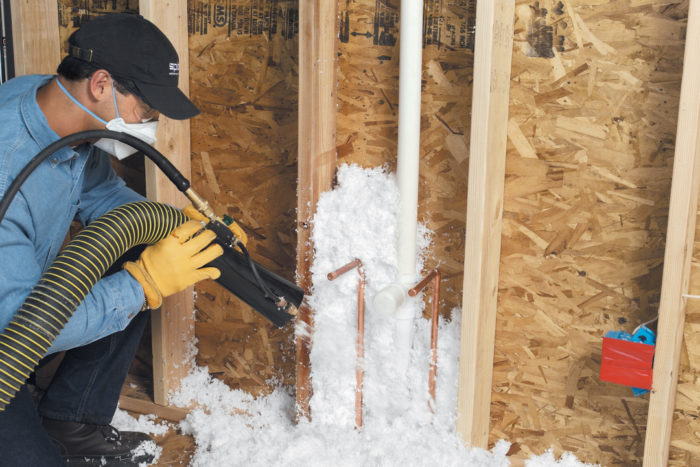
Image Credit: Johns Manville
In Minnesota, Jeff Fredrickson is planning a new house, and his research has included lots of reading on the design and construction of exterior walls. His goals are twofold: a wall that will stay mold-free for decades, and one that is “somewhat energy efficient.”
Starting at the inside, the wall would go like this: drywall, a polyethylene vapor barrier, JM Spider insulation in 2×6 stud walls, 1/2-inch plywood sheathing, a water-resistive barrier (Benjamin Obdyke HydroGap), fiber cement and stone veneer cladding.
“Is this a good wall?” he asks in a Q&A post at GreenBuildingAdvisor.
Specifically, Fredrickson worries about condensation in this Climate Zone 6 wall, the potential hazards of volatile organic compounds in the insulation, and whether the blown-in Johns Manvillle Spider fiberglass insulation is really any better than plain old fiberglass batts.
That’s the focus for this Q&A Spotlight.
First, skip the polyethylene
Although it was commonly used in exterior walls at one time, polyethylene is now regarded as a potential moisture trap in all but the coldest climates.
“The interior polyethylene is more likely to cause moisture problems than solve them, because it prevents your wall from drying to the interior during the summer,” writes GBA senior editor Martin Holladay. “If you don’t want mold, then don’t install the interior poly (especially if there is any chance that the house will ever have air conditioning).”
Poly may present a higher-than-usual risk, Nate G. adds, if Fredrickson puts stone veneer right over the water-resistive barrier.
Holladay has the same misgivings about stone veneer on the exterior, telling Fredrickson, “Stone veneer over wood framing and plywood or OSB wall sheathing is probably the most problematic cladding ever invented. This type of cladding has more moisture-entry problems than any other. Lots of siding types are most…
Weekly Newsletter
Get building science and energy efficiency advice, plus special offers, in your inbox.

This article is only available to GBA Prime Members
Sign up for a free trial and get instant access to this article as well as GBA’s complete library of premium articles and construction details.
Start Free TrialAlready a member? Log in












2 Comments
Stone Veneer Air Gap Membranes
An excellent solution for the stone veneer problem (**especially** if you are considering a more vapor-open sheathing such as fiberboard) would be a vapor impermeable air gap membrane, such as Cosella Dorken Delta-Dry. It is a "waffle pattern" plastic mat: when moisture passes through the sheathing and the WRB/housewrap (outward drying of the wall), it is ventilated up and out through the channels. However, it completely blocks any inward drive issues from the adhered veneer--basically "decoupling" the wet concrete sponge outside of your wood frame wall.
Cosella Dorken DELTA®-DRY
http://www.cosella-dorken.com/bvf-ca-en/products/rainscreen/products/dry.php
John Straube and his crew did side by side tests up in their Canadian exposure site looking at the effectiveness of this product.
PA-0902: Adhered Veneers and Inward Vapor Drives: Significance, Problems and Solutions
http://buildingscience.com/documents/published-articles/pa-adhered-veneers-inward-vapor-drives/view
Response to Kohta Ueno
Kohta,
Thanks for your excellent suggestion.
In my 2011 article, All About Water-Resistive Barriers, I included lots of information on Cosella Dorken Delta-Dry.
In that article, I noted, "While most housewraps depend on vapor diffusion to help walls dry, Delta-Dry depends upon air movement (ventilation) between the Delta-Dry and the wall sheathing. Although Delta-Dry is as vapor-impermeable as 6-mil poly, its grooves allow air to move behind it, carrying moisture away from the sheathing. ... Unlike such conventional WRBs as asphalt felt or Tyvek, however, Delta-Dry has air channels that provide a capillary break and a rainscreen between the siding and the sheathing, facilitating the drainage of liquid water. Delta-Dry also beats felt or Tyvek when it comes to handling solar-driven moisture; since Delta-Dry is vapor-impermeable, it is a total barrier to inward solar vapor drive."
Log in or become a member to post a comment.
Sign up Log in